
A rose is a woody perennial flowering plant of the genus Rosa, in the family Rosaceae, or the flower it bears. There are over three hundred species and tens of thousands of cultivars. They form a group of plants that can be erect shrubs, climbing, or trailing, with stems that are often armed with sharp prickles. Their flowers vary in size and shape and are usually large and showy, in colours ranging from white through yellows and reds. Most species are native to Asia, with smaller numbers native to Europe, North America, and northwestern Africa. Species, cultivars and hybrids are all widely grown for their beauty and often are fragrant. Roses have acquired cultural significance in many societies. Rose plants range in size from compact, miniature roses, to climbers that can reach seven meters in height. Different species hybridize easily, and this has been used in the development of the wide range of garden roses.

Clematis is a genus of about 300 species within the buttercup family, Ranunculaceae. Their garden hybrids have been popular among gardeners, beginning with Clematis × jackmanii, a garden standby since 1862; more hybrid cultivars are being produced constantly. They are mainly of Chinese and Japanese origin. Most species are known as clematis in English, while some are also known as traveller's joy, a name invented for the sole British native, C. vitalba, by the herbalist John Gerard; virgin's bower for C. terniflora, C. virginiana, and C. viticella; old man's beard, applied to several with prominent seedheads; leather flower for those with fleshy petals; or vase vine for the North American Clematis viorna.

Delphinium bakeri, or Baker's larkspur, is a species of perennial herb in the buttercup family, Ranunculaceae. It is endemic to California in the United States, where it is a federally listed endangered species. It is known in the wild from one remaining occurrence near Salmon Creek in Sonoma County, where only seven plants remained as of March 2006.
Persoonia micranthera, commonly known as the small-flowered snottygobble, is a species of flowering plant in the family Proteaceae and is endemic to a restricted area in the south-west of Western Australia. It is a low-lying to prostrate shrub with branchlets that are hairy when young, spatula-shaped to lance-shaped leaves with the narrower end towards the base, hairy yellow flowers borne in groups of four to fifteen, and smooth, oval fruit.

Delphinium luteum, known by the common name yellow larkspur, is a species of small perennial herb in the buttercup family bearing bright yellow cornucopia-shaped flowers. Endemic to the rocky, foggy hillsides of coastal Sonoma County, California, it is critically endangered, with about 200 individuals believed to be in existence as of 2005.
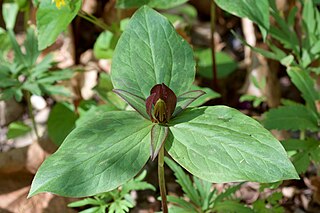
Trillium sessile is a species of flowering plant in the bunchflower family Melanthiaceae. The specific epithet sessile means "attached without a distinct stalk", an apparent reference to its stalkless flower. It is commonly known as toadshade or toad trillium. It is also called sessile trillium or sessile-flowered wake-robin,, however it is not the only member of the genus with a sessile flower.

Orobanche uniflora, commonly known as one-flowered broomrape, one-flowered cancer root, ghost pipe or broomrape, is an annual parasitic herbaceous plant. It is native to much of North America, where it is a parasitic plant, tapping nutrients from many other species of plants, including those in the families Asteraceae and Saxifragaceae and in the genus Sedum. The name "orobanche" can be translated to "vetch-strangler" and "uniflora" can be translated to "single-flower".

Delphinium andersonii is a species of perennial larkspur known as Anderson's larkspur. This wildflower is native to western North America, where it can be found in the Great Basin and the Sierra Nevada.

Delphinium depauperatum is a species of larkspur known by the common names slim larkspur and dwarf larkspur. This wildflower is native to western North America where it is found in mountain meadows. It grows from a short root and erects a stem usually under 40 centimeters in maximum height. The small leaves are divided into lobes and are usually located about the base of the plant. Toward the top of the stem are flowers on long pedicels, with usually not more than 20 flowers per plant. The flowers generally have deep dark blue sepals which are flat and extended to the sides, and petals which are mainly the same color except for the top two, which may be lighter blue to white. The spur is between one and two centimeters long.

Delphinium gypsophilum is a species of larkspur known by the common name Pinoche Creek larkspur. It is endemic to California, where it grows throughout the central part of the state in woodland and grassland. This wildflower generally reaches between one half and one meter in height. Its pale whitish-green stem is topped with cylindrical inflorescences of up to 30 flowers on short pedicels. The flowers are chalk-white, sometimes drying to a faint blue. Occasional individuals bear pink or light blue flowers. The spur is one to one and a half centimeters long.

Delphinium hesperium is a species of larkspur known by the common name foothill larkspur. It is also sometimes called western larkspur and coastal larkspur, but these names are less specific since other species share them. It is endemic to California, where it grows in woodland and grassland in the northern half of the state. This wildflower generally reaches one half to one meter in height. It has deeply lobed, prominently veined leaves, mostly located near the base of the plant. The inflorescence may hold very few to over 100 flowers, each on a long, thick pedicel. The flowers are usually a brilliant blue or purple, and sometimes lighter pinkish to white. Often the sepals are dark in color and the petals lighter. The spur is about one to two centimeters long.
Delphinium hutchinsoniae is a rare species of larkspur known by the common names Monterey larkspur and Hutchinson's larkspur. It is endemic to California, where it is known only from Monterey County. This wildflower reaches a meter in height but is usually shorter. The leaves are divided into lobes which are further divided into smaller lobes, and they are mostly located low on the plant. The top of the thin, erect stem is occupied by an inflorescence of not more than ten flowers. Each flower has sepals which are brilliant purple or blue to lavender, two petals which are the same color, and two upper petals which are usually white. The spur is up to two centimeters long and curves down at the tip.
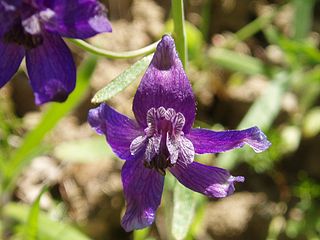
Delphinium variegatum is a species of larkspur known by the common name royal larkspur. It is endemic to California, where it grows in mountains, valley and coast in woodlands and grasslands. On the forest floor of California oak woodlands typical plant associates are Calochortus luteus, Cynoglossum grande and Calochortus amabilis.

The Loch Lomond Vernal Pool Ecological Reserve is a nature reserve of 8.22 acres (33,300 m2) in the community of Loch Lomond in Lake County, California. It is one of 119 ecological reserves managed by the California Department of Fish and Game (CDFG). The ecological reserve system was authorized by the state legislature in 1968 for the purpose of conservation and protection of rare plants, animals and habitats.
Delphinium inopinum is a species of larkspur known by the common name unexpected larkspur. It is endemic to the Sierra Nevada of California, where it is known mostly from rocky areas in open temperate coniferous forest habitat.

Delphinium stachydeum is a species of larkspur known by the common name spiked larkspur. It is native to the Pacific Northwest and Great Basin of the United States, where it grows in sagebrush scrub and along the edges of mountain forest habitat where it meets prairie and plateau. It is a perennial herb producing at least one erect, slightly hairy stem generally exceeding a meter in height. The multilobed leaves are located mainly on the lower half of the stem except for the area just above ground level. The inflorescence is a branching array of usually more than 30 flowers, each held on a long pedicel. The flower has bright blue sepals around a centimeter long fringed with hairs and surrounding smaller, paler petals. The spur at the back of the flower is just over a centimeter in length.
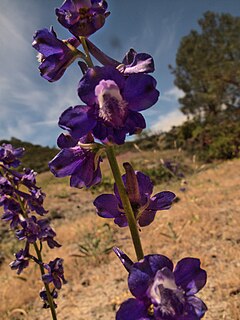
Delphinium uliginosum is a species of larkspur known by the common names swamp larkspur and bog larkspur. It is endemic to California, where it is known from very localized populations in the Inner North Coast Ranges. It grows in chaparral, grassland, and other habitat in the hills, generally on serpentine soils. This is a perennial herb producing a hairless, erect stem up to 70 centimeters tall. It can be identified by its leaves, which are fan-shaped, a characteristic unique among the larkspurs, which generally have palmate leaves with narrow, fingerlike lobes. The inflorescence bears up to 45 flowers, each on an upright pedicel which may exceed 10 centimeters long. The flower is blue with the longest sepals 1.4 centimeters long and a spur about the same length. The fruit is one or two centimeters long.
Delphinium umbraculorum is a species of larkspur known by the common name umbrella larkspur. However, its epithet does not denote an umbrella. Instead, it describes the habitat of this plant, usually shady and cool places. It is often confused with D. parryii which has similar flowers and D. patens which has similar stems and leaves. It is endemic to California, where it grows in the woodlands of the coastal mountain ranges from Monterey to Ventura Counties. It is a perennial herb producing an erect stem 40 to about 80 centimeters tall. The hairless leaves are located at the base of the plant and along the stem as well. The inflorescence bears several flowers with reflexed dark blue sepals and a spur over a centimeter long. The fruit is between 1 and 2 centimeters long.
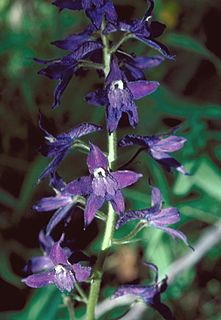
Delphinium barbeyi is a species of flowering plant in the buttercup family known by the common names subalpine larkspur, tall larkspur, and Barbey's larkspur. It is native to the interior western United States, where it occurs in the states of Arizona, Colorado, New Mexico, Utah, and Wyoming.
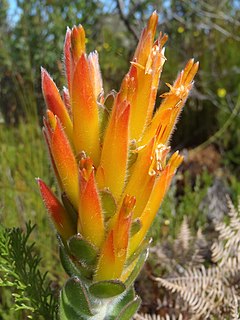
Mimetes pauciflorus, the three-flowered pagoda, is an evergreen, shyly branching, upright shrub of 2–4 (6½–13 ft) high, from the family Proteaceae. It has narrowly to broadly oval leaves of 2½–4 cm (1.0–1.6 in) long and ¾–2 cm (0.3–0.8 in) wide, on the upper parts of the branches, the lower parts leafless with a reddish brown bark. The inflorescences at the top of the shoots are cylinder-shaped, 10–40 cm (4–16 in) long and contain forty to one hundred twenty densely crowded flower heads, at a steep upward angle, hiding a crest of very small, almost vertical leaves. The flower heads each consist of three, rarely four individual flowers. The flowers are tightly enclosed by four or five orange-yellow, fleshy, pointy, lance-shaped involucral bracts, and three orange-yellow, 4–5½ cm (1.6–2.4 in) long bracteoles. It grows on always moist, south-facing slopes in the southern coastal mountains of South Africa. Flowers can be found from August to November, with a peak in September.















